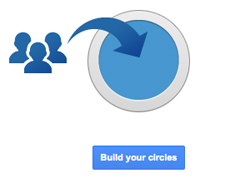This guest-post was written by Mary Walker. Mary is a junior at the University of Georgia. She is studying public relations and consumer-journalism, with the intention of attending graduate school for corporate communications. Mary was recently an intern at Heideldesign. Contact her at mkwalker22@gmail.com.
You've heard about Google+, and if you're already one of the millions of people using Facebook, you may be asking, "Another social network? But why?"
It's true that Google+ and Facebook have many things in common, but there are also distinct differences. We'll outline some of them for you here.
When Facebook was created, it used exclusivity as its promotional technique. However, Google+ is using discretion. Google+ allows you to share different information with different people to simulate the variety of relationships you have in real life. For example, you wouldn't tell your best friend the same things you'd tell your boss. Why should your online profile be any different?
Now, let's break down some of the unique features of Google+, like Circles, Hangouts, Sparks and Huddle.
Circles
 Circles may be the most significant feature of Google+. Circles allow users to put their friends into as many different groups as they want. By separating your contacts into groups, you can control what your friends see. For example you can have separate circles for a Ski Trip group, high school friends, co-workers and family.
Circles may be the most significant feature of Google+. Circles allow users to put their friends into as many different groups as they want. By separating your contacts into groups, you can control what your friends see. For example you can have separate circles for a Ski Trip group, high school friends, co-workers and family. The creators of Google+ are betting on the fact that not all users want to share everything with everyone. As multiple generations become heavy users of social networking, it is becoming more important to give users greater control over who can access their information.
Google+ also allows users to specify what kind of information they want to see from their other contacts. Unlike Facebook, updates are not all pooled into one location such as "Most Recent." Updates are confined to that person's circle, making it less overwhelming for users as they accumulate friends.
Friends
Google+ seems to have taken its inspiration from Twitter when it comes to "friending" people. On Google+, information sharing between contacts does not have to be mutual. Unlike Facebook, a user can follow anyone who accepts them, and yet not allow them to see any of their personal information.
Hangouts
Google wanted to bring unplanned meet-ups to the web, and thus "Hangouts" were created. Hangouts are the online equivalent of walking into a coffee shop and seeing different people you know.
 Hangouts are a feature of Google+ that allows people to see who is online a have a quick face-to-face chat. Before Facebook released its video chat, this was a unique feature to Google+. But it is still very different in that Hangouts allow multiple people to be in the same room at the same time. Users can create a group chat of up to 10 people.
Hangouts are a feature of Google+ that allows people to see who is online a have a quick face-to-face chat. Before Facebook released its video chat, this was a unique feature to Google+. But it is still very different in that Hangouts allow multiple people to be in the same room at the same time. Users can create a group chat of up to 10 people. Sparks
 Google+ Sparks is a feature that has no Facebook equivalent. Sparks allows users to tell the website the types of things they are interested in such as "sports" or "cooking" and it will bring up cool new videos or information about the topic.
Google+ Sparks is a feature that has no Facebook equivalent. Sparks allows users to tell the website the types of things they are interested in such as "sports" or "cooking" and it will bring up cool new videos or information about the topic. Google+ combines social networking with the search engine tools already in place. Facebook allows users to share information for which they've already searched, but Sparks allows the search engine to find interesting stuff for you to post to your friends.
Streams
Streams and Statuses are interchangeable. The creators of Google+ recognized peoples' desire to know what their friends are doing and thinking. The status feature is an integral part of Facebook that needed to be converted to Google+.
Huddle
Huddle is a feature that allows you to have a Google+ chat on your phone. This allows you to text your plans with a group on your phone. It allows up to 10 people to be in the chat at one time to make organizing group activities easier. The whole conversation will show up on your phone.

Google+ was released to select users at the end of June, and is currently an "invite-only" program for people over the age of 18. Google+ attracted 5 million users within two weeks of opening.
